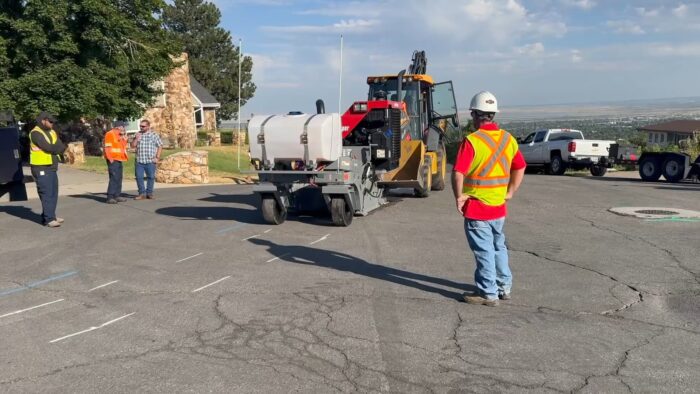Building Broadband: Emerging Safety Protocols & Technologies for Underground Utility Contractors
Underground utility contractors are increasingly relying on horizontal directional drilling HDD as the demand for broadband services increases. Laying fiber optic cable underground with HDD has many long term benefits.
These include avoiding damage to road surfaces and reduced asphalt removal needs. However, this efficiency is not without a high cost. In many areas, underground utility marking is incomplete and outdated. This leaves horizontal directional drilling companies struggling to safely do their jobs.
No example brings this point home more than an explosion April 2025 in Lexington, Missouri. A natural gas leak occurred during a horizontal directional drilling job to install underground fiber. This caused a house to explode, costing the life of a child and leaving other family members in critical condition.
Local newspapers report that the subcontractor installing the underground broadband followed safety procedures correctly. This included calling 811 to establish the location of underground utilities. They also waited the appropriate amount of time before digging.
Tragically, 811 was not aware of the gas line and consequently did not mark it. This highlights the importance of understanding underground fiber optic cable installation standards on underground utilities jobs, particularly for horizontal directional drilling contractors.
New Utility Trenching Regulatory and Safety Overhaul
After a 2023 explosion at a factory in Pennsylvania, the National Transportation Safety Board (NTSB) conducted a thorough investigation. They determined that one factor in the explosion was unmarked underground steam pipes near natural gas lines. Another factor was a gas shutoff valve under a paved surface.

NTSB recommended widespread use of the Common Ground Alliance’s Best Practice 3-26 on 811 center membership. This will help ensure proper HDD safety standards. The Best Practices 21.0 is a comprehensive guide for underground safety compiled and distributed by the Common Ground Alliance. It offers guidelines on safe excavation for everything from HDD jobs to pipe trench excavating on construction sites.
Horizontal Directional Drilling Restrictions
The rapid expansion of fiber installation has led to increased restrictions on HDD in some United States urban areas. In fact, Albuquerque, New Mexico and Katy, Texas banned HDD altogether because of an increase in broken utility lines.
A June 2025 article published in Underground Infrastructure says a hot market and inexperienced horizontal directional drilling contractors may be causing this problem. This results in more accidents and cut corners prior to the installation process. It could also lead to more areas where authorities do not allow HDD. This means residents without access to fiber internet.
Alternatives to Saw Cutting Asphalt and HDD
Undoubtedly the use of HDD for trenching utilities on construction projects will continue to expand. However, when asphalt trenching is neccesary, asphalt grinding machines are a faster and more cost effective alternative to saw-cutting / asphalt cutting. Grinding asphalt surfaces avoids saw cutting, chunking, loading, hauling and asphalt material disposal.
Portable asphalt grinder attachments remove asphalt on the job site at an approximate rate of 14 cents/square foot which is a substantial cost savings. An asphalt grinding machine can open a 400 foot trench of pavement surface in as little as 30 minutes, which is also a significant time savings. By milling asphalt, contractors reuse the recycled asphalt product (RAP) as trench fill. This form of asphalt recycling helps get the job done much quicker at a significantly lower cost.
Conclusion
As more people want broadband, we need to focus on safety. This is especially true on horizontal directional drilling jobs. While HDD offers speed and surface preservation, recent tragedies highlight the dangers of relying on incomplete utility locates.
Regulatory bodies and industry leaders are updating best practices and safety guidelines. However, enforcement and training need to keep up. In some areas, HDD cannot be used.
In these cases, asphalt grinding is a safer and more affordable option for utility trenching in asphalt. Utility contractors can meet the growing needs for infrastructure by using new technologies and following safety standards. This way, they ensure that public safety remains uncompromised.
Key Takeaways – Horizontal Drilling Safety for Utility Trenching
- Contractors are increasing horizontal directional drilling to expand broadband.
- HDD helps avoid surface damage but creates safety risks. When workers don’t have accurate maps of underground utilities, they risk hitting pipes or cables.
- Outdated or missing utility maps cause serious accidents. Workers sometimes strike unmarked gas lines or steam pipes, leading to explosions and injuries.
- Contractors follow safety rules but still face hidden dangers. In some cases, they call 811 and wait, but the system fails to identify all buried lines.
- Safety leaders are recommending new protocols like Common Ground Alliance’s Best Practices 21.0 to protect crews and communities.
- Cities like Albuquerque and Katy have banned HDD after accidents. These cities saw too many utility strikes and chose to stop HDD to prevent further damage.
- Contractors use asphalt grinders as a safer trenching option. These machines grind asphalt on-site, reduce costs, and allow workers to recycle the old material as trench fill.
